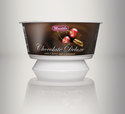A star performer
29 September 2011Joanne Hunter rounds up examples of speciality paper grades that support brand aims in both leading and supporting roles
Making brand packaging ‘come alive’ with its own personality is one of many roles that paper is asked to play. Paper also supports a host of print finishes specified to ensure that shoppers at a glance can pick out a product on the crowded stage of a ‘retail theatre’. But in whatever role they play, speciality and fine paper grades put in a memorable performance.
A paper-based labelling solution is ready to team up with rigid plastics to give luxury goods and everyday food brands the high-impact visuals and ecological benefits they want. The speciality paper by Stora Enso is designed for use with polypropylene (PP) injection-moulded containers that normally carry a printed film label.
In the process known as in-mould labelling (IML), the label is placed in the mould before injecting plastics melt to create a finished pot. New InnoMould paper can now be specified for pots of yoghurt and dairy products, containers for processed fish and butter, as well as large paint buckets, for example.
The paper combines with the plastics melt to form an integral unit and the result is claimed to offer a much stiffer alternative. This, says Stora Enso, gives the pot a higher bearing pressure, allowing for higher stacking, and the walls of the pots can be produced with less plastics material.
With realistic aesthetics greatly in demand for advertising impact, the InnoMould option is desirable because it supports the use of high-resolution visuals and numerous different colours, including gold and silver, states the company.
Similarly, Flextrus is busy developing advanced packaging materials that work with plastics, at the same time aiming to reduce reliance on and use of fossil fuel-based raw materials.
Flextrus PaperLite is thermoformable and designed to substitute 100% plastics material for tray making. Properties including stretch-ability minimise the amount of plastics used while still providing a high barrier and well functioning packaging material, says Flextrus marketing manager Ingrid Lidbäck. “The paper is unique in being able to run and thermoform in existing packaging lines (without the need for costly investments) and with our extrusion technology we can provide the paper with thin high barrier coatings and sealing layers, so that the total packaging material uses up to 75-90% less plastics.”
Lidbäck continues: “Not only the paper part, but the whole Flextrus PaperLite product is FSC certified. Additionally, our PaperLite is lighter than 100% plastics materials, so the overall impact from the transportation, distribution and packaging fees are substantially reduced. And from the customer attraction point of view, Flextrus PaperLite gives a true paper look and feel, which enables great marketing opportunities and differentiation in the shops.”
Last year, Marks & Spencer introduced it for its premium house-branded processed meat products, to gain environmental benefits and business advantages. Reportedly, its use of Flextrus PaperLite resulted in 27% less packaging.
Groundbreaking
Thimm, of Germany, produces preprinted corrugated board packaging using flexo, digital and offset printing processes.
Oliver Rokohl, director sales and marketing at Thimm Verpackung, comments: “We work in a highly competitive market so we’re always interested in exploring groundbreaking products that can help us strengthen our position in key markets and give us the edge over competitors. To achieve excellent printing performance you need a well-engineered flexo preprint technology and a top quality paper.”
Catering to all its needs is said to be Sappi Fusion. This lightweight, premium quality, high bright, white top liner uses 100% bleached virgin fibres.
According to Rokohl, ThimmColor products can be improved with Fusion, which provides brilliant gloss characteristics and intense colours.
Plus, Rokohl adds, it offers an “ecological alternative” to using UV coatings, and produces even finer printing dots, as well as improved colour vignetting.
With Sappi Fusion, the flexo preprint reaches a quality level that is comparable to offset print “even for lightweight grammages”. It offers the utmost degree of whiteness and is suitable for direct contact with foodstuff and efficient processing on the corrugators, diecutters and flexo folder gluers.
Rokohl says the grade easily handles the demands of high quality printing, in terms of variegation (number of colours), quality of illustrations and photo-realistic images, grade of brilliance and screen definition. Fusion apparently comes on the market perfectly timed to accommodate the trend towards using more colours. Over the past two years, 70% of the corrugated boxes sold in Germany were printed using some colour, and of those 15% used three or more. Currently, 20% of the orders at Thimm are multi-colour orders, with nearly half printed with five or more colours.
Rokohl says: “Compared with our industry, our ratio in preprinted packaging is five times higher than the average. Since the end of the 70s, we have developed this market intensively and are convinced that there remains further potential for growth.”
The environment was another key consideration in Thimm’s decision to use Sappi Fusion, explains Rokohl. “Corrugated board is a very eco-friendly packaging material, and demand for corrugated board packaging made from paper produced by certified forestry will continue to rise.”
Thimm is also witnessing growth potential in markets where secondary packaging supports the sale of products, such as retail and shelf-ready packaging. For example, packaging for electronic equipment features an illustration of the product and essential information with plain secondary packaging, while packaging for foodstuffs supports the product packing with consistent branding. “There is much potential for optimisation in this market,” says Rokohl.
Presentation for meat Ham InnoMould paper from Stora Enso is suitable for IML labelling of containers in the dairy, processed fish and paint sectors InnoMould Flextrus offers a formable paper-based solution Flextrus




